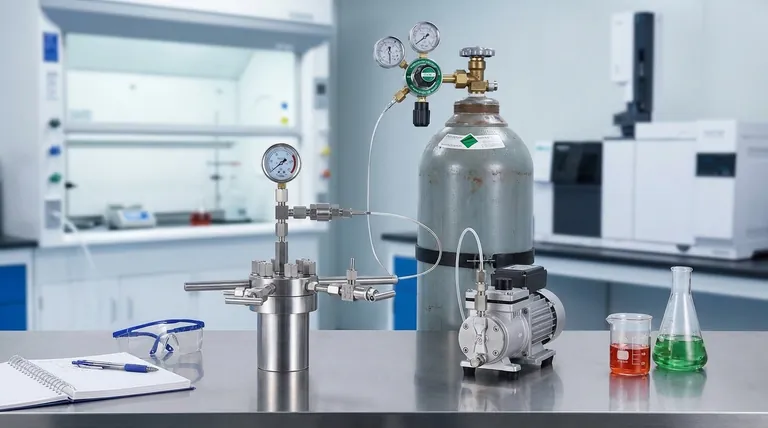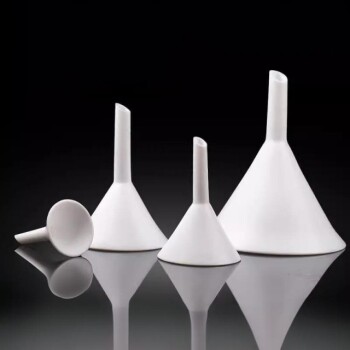In a laboratory setting, high pressure is not just contained; it is actively generated and precisely controlled. This is achieved by physically compressing a fluid—either a liquid or a gas—within a specialized, sealed container known as a pressure vessel or autoclave. The pressure is increased using external devices like pumps and compressors or by carefully heating the sealed system to induce thermal expansion.
The generation of high pressure in a lab relies on a fundamental principle: reducing the effective volume for a fluid within a robust, sealed vessel. The specific method—be it mechanical compression or thermal expansion—is chosen based on the required pressure, the chemical system, and paramount safety protocols.

The Foundation: The High-Pressure Vessel
Before pressure can be generated, it must be safely contained. This is the role of the high-pressure vessel, often called an autoclave in a lab context.
The Importance of Thick Walls
As noted in high-pressure safety literature, these reactors are built with thick-walled metal. This design is not arbitrary; it is a direct countermeasure to the immense physical force, or hoop stress, that the internal pressure exerts on the container walls.
The thickness and material choice (e.g., stainless steel, Hastelloy) are carefully engineered to ensure the vessel remains well within its mechanical limits, preventing deformation or catastrophic rupture.
Sealing is Non-Negotiable
A vessel is only as strong as its seal. High-pressure systems use specialized gaskets, O-rings, and precision-machined sealing surfaces to create a leak-proof environment. Even a minuscule leak can prevent the system from reaching its target pressure and may pose a significant safety hazard.
Core Methods for Generating Pressure
Once a sealed vessel is established, several methods can be used to increase the internal pressure.
Method 1: Pressurizing with a Gas Cylinder
This is the most direct method for moderate pressures. A standard high-pressure cylinder of an inert gas (like Nitrogen or Argon) or a reactant gas (like Hydrogen) is connected to the vessel through a pressure regulator.
The regulator precisely controls the delivery pressure, allowing the operator to slowly fill the vessel until it reaches the desired setpoint, typically up to the cylinder's regulated output limit (e.g., 100-200 bar).
Method 2: Mechanical Compression with a Pump
For liquid-phase reactions or achieving very high pressures, a high-pressure pump is used. These are positive displacement pumps, similar in principle to an HPLC pump.
The pump draws liquid from a reservoir and forces it into the sealed vessel. Since liquids are nearly incompressible, each stroke of the pump adds a small, fixed volume, causing a rapid and controlled increase in system pressure.
Method 3: Amplification with a Gas Booster
When pressures are needed that exceed what a standard gas cylinder and regulator can provide, a gas booster or compressor is employed.
A booster works like a pressure amplifier. It uses a low-pressure gas supply to drive a large piston, which in turn drives a smaller piston that compresses the target gas to a much higher pressure. This allows labs to reach thousands or even tens of thousands of PSI.
Method 4: Thermal Generation
According to fundamental gas laws, the pressure of a gas in a fixed volume is directly proportional to its temperature. This principle can be used to generate pressure.
By sealing a vessel with a specific amount of a solvent or gas at room temperature and then heating it, the internal pressure will rise predictably. This method is effective but requires extremely accurate calculations and robust safety interlocks to prevent over-pressurization from runaway heating.
Understanding the Trade-offs and Safety Imperatives
Working with high pressure introduces significant inherent risks that dictate equipment design and procedure.
The Hazard of Stored Energy
A pressurized vessel contains an enormous amount of stored potential energy. This is especially true for gases, which are highly compressible.
A sudden failure of a gas-pressurized vessel results in an explosive release of this energy, a dangerous event known as a physical explosion. Liquid-pressurized (hydrostatic) systems contain far less stored energy and are inherently safer, as a leak typically results in a simple jet of liquid rather than a catastrophic blast.
Material Compatibility and Embrittlement
The choice of vessel material is critical. Certain gases, most notably hydrogen, can cause a phenomenon called hydrogen embrittlement, where the gas weakens the vessel's metal structure over time, leading to unexpected failure at pressures far below its design limit.
Non-Negotiable Safety Features
All laboratory pressure systems must be equipped with safety devices. A rupture disc is a thin metal diaphragm designed to burst at a specific, predetermined pressure, safely venting the contents. A pressure relief valve is a spring-loaded valve that opens to vent pressure when it exceeds a set limit and then reseals, providing ongoing protection.
Making the Right Choice for Your Experiment
The ideal method for generating pressure is dictated by your specific scientific goal and safety constraints.
- If your primary focus is moderate gas-phase reactions (e.g., hydrogenation): Direct pressurization from a regulated gas cylinder is often the most straightforward and cost-effective approach.
- If your primary focus is achieving very high pressures (>200 bar or 3000 psi) for catalysis or material science: A gas booster for gases or a high-pressure liquid pump for liquids is typically required.
- If your primary focus is exploring solvent behavior near its critical point: Controlled heating of a sealed vessel is the most direct method, but it demands precise temperature control and pressure monitoring.
By understanding these core principles of generation and containment, you can safely and effectively harness the power of high pressure to drive chemical discovery.
Summary Table:
| Method | Typical Use Case | Key Equipment |
|---|---|---|
| Gas Cylinder & Regulator | Moderate gas-phase reactions (e.g., hydrogenation) | Pressure regulator, inert/reactive gas cylinder |
| Mechanical Pump | Liquid-phase reactions, very high pressures | High-pressure (HPLC-style) pump |
| Gas Booster | Extremely high gas pressures for catalysis/material science | Gas booster/compressor |
| Thermal Generation | Exploring solvent behavior near critical point | Sealed vessel with precise temperature control |
Ready to implement high-pressure processes in your lab safely and effectively? KINTEK specializes in high-quality lab equipment and consumables, including robust pressure vessels, precision pumps, and regulators. Our expertise ensures you get the right solution for your specific pressure generation needs, from hydrogenation to advanced material synthesis. Contact our experts today to discuss how we can support your laboratory's high-pressure requirements!
Visual Guide

Related Products
- Customizable High Pressure Reactors for Advanced Scientific and Industrial Applications
- High Pressure Laboratory Vacuum Tube Furnace Quartz Tubular Furnace
- Laboratory Sterilizer Lab Autoclave Vertical Pressure Steam Sterilizer for Liquid Crystal Display Automatic Type
- Anti-Cracking Press Mold for Lab Use
- Laboratory Sterilizer Lab Autoclave Pulse Vacuum Lifting Sterilizer
People Also Ask
- What is a high pressure high temperature autoclave reactor? Unlock Extreme Chemical Synthesis
- Does pressure affect melting and boiling? Master Phase Changes with Pressure Control
- What is the temperature range of a stainless steel reactor? Understand the Real-World Limits for Your Process
- What are the advantages of a chemical reactor? Unlock Precision, Efficiency, and Safety in Your Process
- What reactor is used for high pressure reactions? Select the Right Autoclave for Your Lab



















